Playfight Collection (#2)
In the rural filling station near Chapel Hill, North Carolina in 1939, a surprising transformation occurred
For sale as Licensed Images
Choose your image, Select your licence and Download the media
In the rural filling station near Chapel Hill, North Carolina in 1939, a surprising transformation occurred. What was once just a place to refuel and rest became a vibrant community center filled with laughter and playfulness. As captured by Dorothea Lange's lens, this unexpected change brought joy to the lives of locals who found solace in loafing around. Meanwhile, on the front cover of a serialized version of The Three Musketeers, we are transported into an adventurous world where sword fights and playful banter reign supreme. The spirit of camaraderie among these musketeers is evident as they engage in their thrilling playfight. Across time and continents, even polar bears couldn't resist the allure of playfighting. In London Zoo back in 1926, two majestic polar bears romped gleefully in their pool. Their black-and-white photo captures the sheer delight that comes from engaging in friendly combat. The Melee painting depicts another form of playful skirmish - one that takes us back centuries ago when knights clashed swords on horseback. This oil on canvas masterpiece immortalizes the intensity and excitement that accompanies such battles. Moving forward to Linton Park's Flax Scutching Bee from 1885 brings us closer to nature's own playfight scene. Amidst fields filled with flax plants, people gather for a day filled with fun-filled competition while scutching flax fibers together. Laughter echoes through the air as friends challenge each other amidst this unique communal event. Traveling across oceans to Tokyo in 1904 reveals yet another facet of spirited playfight - Japanese schoolboys displaying their warlike spirit within Ueno Park. These young warriors showcase their skills and determination as they engage each other fearlessly but harmlessly. Shakespeare himself recognized the entertainment value of playful conflict as seen in Act III Scene III of Merry Wives of Windsor during the eighteenth century.










